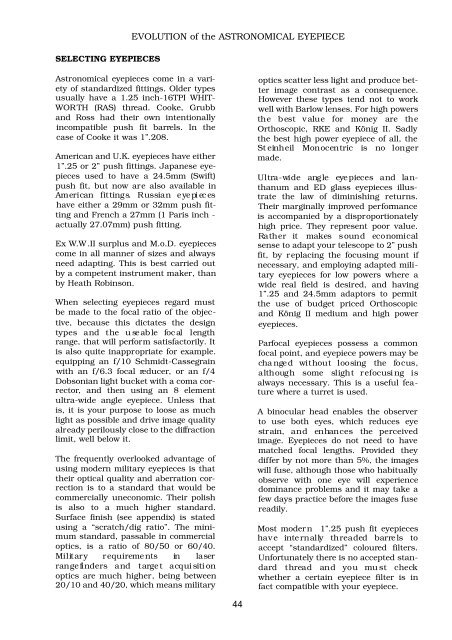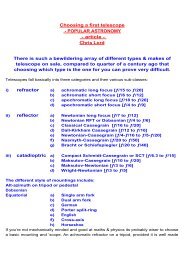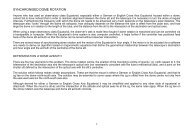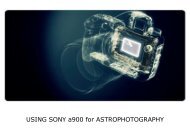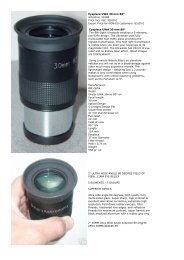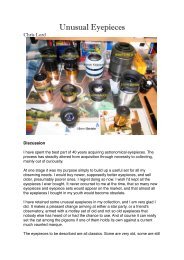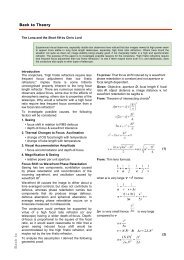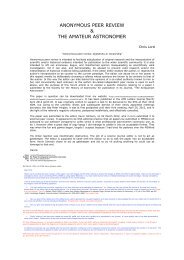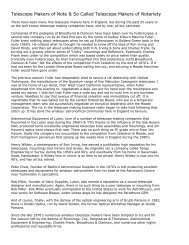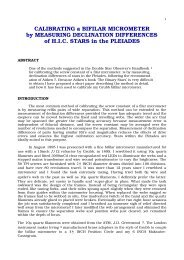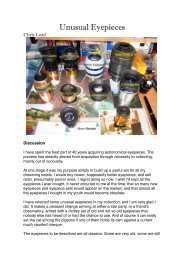Evolution of the Astronomical Eyepiece - Brayebrook Observatory
Evolution of the Astronomical Eyepiece - Brayebrook Observatory
Evolution of the Astronomical Eyepiece - Brayebrook Observatory
Create successful ePaper yourself
Turn your PDF publications into a flip-book with our unique Google optimized e-Paper software.
SELECTING EYEPIECES<br />
EVOLUTION <strong>of</strong> <strong>the</strong> ASTRONOMICAL EYEPIECE<br />
<strong>Astronomical</strong> eyepieces come in a variety<br />
<strong>of</strong> standardized fittings. Older types<br />
usually have a 1.25 inch-16TPI WHIT-<br />
WOR TH (RAS) thread. Cooke, Grubb<br />
and Ross had <strong>the</strong>ir own intentionally<br />
incompatible push fit barrels. In <strong>the</strong><br />
case <strong>of</strong> Cooke it was 1”.208.<br />
American and U.K. eyepieces have ei<strong>the</strong>r<br />
1”.25 or 2” push fittings. Japanese eyepieces<br />
used to have a 24.5mm (Swift)<br />
push fit, but now are also available in<br />
American fittings. Russian e ye pi ec es<br />
have ei<strong>the</strong>r a 29mm or 32mm push fitting<br />
and French a 27mm (1 Paris inch -<br />
actually 27.07mm) push fitting.<br />
Ex W.W.II surplus and M.o.D. eyepieces<br />
come in all manner <strong>of</strong> sizes and always<br />
need adapting. This is best carried out<br />
by a competent instrument maker, than<br />
by Heath Robinson.<br />
When selecting eyepieces regard must<br />
be made to <strong>the</strong> focal ratio <strong>of</strong> <strong>the</strong> objective,<br />
because this dictates <strong>the</strong> design<br />
types and <strong>the</strong> u se ab le foc al length<br />
range, that will perform satisfactorily. It<br />
is also quite inappropriate for example.<br />
equipping an f/10 Schmidt-Cassegrain<br />
with an f/6.3 focal reducer, or an f/4<br />
Dobsonian light bucket with a coma corrector,<br />
and <strong>the</strong>n using an 8 element<br />
ultra-wide angle eyepiece. Unless that<br />
is, it is your purpose to loose as much<br />
light as possible and drive image quality<br />
already perilously close to <strong>the</strong> diffraction<br />
limit, well below it.<br />
The frequently overlooked advantage <strong>of</strong><br />
using modern military eyepieces is that<br />
<strong>the</strong>ir optical quality and aberration correction<br />
is to a standard that would be<br />
commercially uneconomic. Their polish<br />
is also to a much higher standard.<br />
Surface finish (see appendix) is stated<br />
using a “scratch/dig ratio”. The minimum<br />
standard, passable in commercial<br />
optics, is a ratio <strong>of</strong> 80/50 or 60/40.<br />
Military re q u i reme nts in laser<br />
range finders and targe t acqui siti on<br />
optics are much higher, being between<br />
20/10 and 40/20, which means military<br />
optics scatter less light and produce better<br />
image contrast as a consequence.<br />
However <strong>the</strong>se types tend not to work<br />
well with Barlow lenses. For high powers<br />
<strong>the</strong> b est v alue for money are <strong>the</strong><br />
Orthoscopic, RKE and König II. Sadly<br />
<strong>the</strong> best high power eyepiece <strong>of</strong> all, <strong>the</strong><br />
St einheil Monocentric is no longer<br />
made.<br />
Ultra-wide angle eye pieces and lanthanum<br />
and ED glass eyepieces illustrate<br />
<strong>the</strong> law <strong>of</strong> diminishing returns.<br />
Their marginally improved performance<br />
is accompanied by a disproportionately<br />
high price. They represent poor value.<br />
Ra<strong>the</strong>r it makes s ound economical<br />
sense to adapt your telescope to 2” push<br />
fit, by replacing <strong>the</strong> focusing mount if<br />
necessary, and employing adapted military<br />
eyepieces for low powers where a<br />
wide real field is desired, and having<br />
1”.25 and 24.5mm adaptors to permit<br />
<strong>the</strong> use <strong>of</strong> budget priced Orthoscopic<br />
and König II medium and high power<br />
eyepieces.<br />
Parfocal eyepieces possess a common<br />
focal point, and eyepiece powers may be<br />
cha nge d without loosing <strong>the</strong> focus,<br />
although some slight refocusi ng is<br />
always necessary. This is a useful feature<br />
where a turret is used.<br />
A binocular head enables <strong>the</strong> observer<br />
to use both eyes, which reduces eye<br />
strain, and enhances <strong>the</strong> perc e i v e d<br />
image. <strong>Eyepiece</strong>s do not need to have<br />
matched focal lengths. Provided <strong>the</strong>y<br />
differ by not more than 5%, <strong>the</strong> images<br />
will fuse, although those who habitually<br />
observe with one eye will experience<br />
dominance problems and it may take a<br />
few days practice before <strong>the</strong> images fuse<br />
readily.<br />
Most moder n 1”.25 push fit eyepieces<br />
hav e inte rnally threaded barre ls to<br />
accept “standardized” coloured filters.<br />
Unfortunately <strong>the</strong>re is no accepted stand<br />
a rd thread and you mu st check<br />
whe<strong>the</strong>r a certain eyepiece filter is in<br />
fact compatible with your eyepiece.<br />
44


